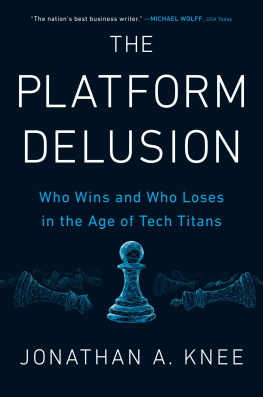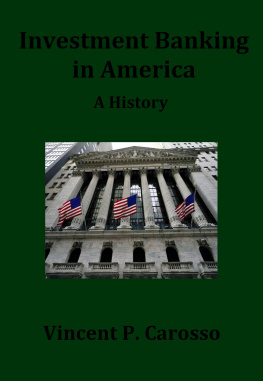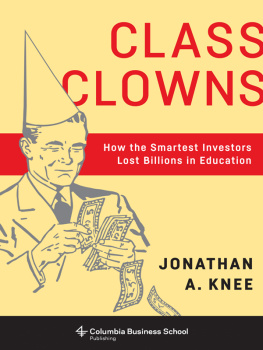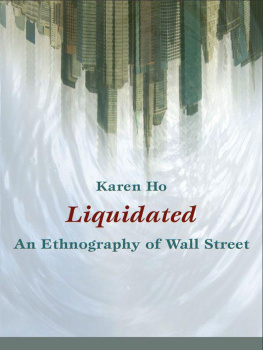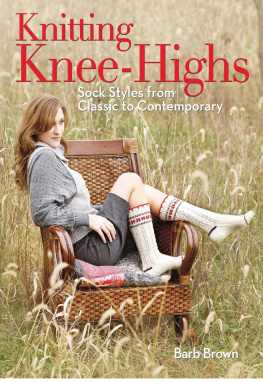THE ACCIDENTAL INVESTMENT BANKER
THE ACCIDENTAL INVESTMENT BANKER
Inside the Decade That Transformed Wall Street
JONATHAN A. KNEE


Oxford University Press, Inc., publishes works that further
Oxford Universitys objective of excellence
in research, scholarship, and education.
Oxford New York
Auckland Cape Town Dar es Salaam Hong Kong Karachi
Kuala Lumpur Madrid Melbourne Mexico City Nairobi
New Delhi Shanghai Taipei Toronto
With offices in
Argentina Austria Brazil Chile Czech Republic France Greece
Guatemala Hungary Italy Japan Poland Portugal Singapore
South Korea Switzerland Thailand Turkey Ukraine Vietnam
Copyright 2006 by Jonathan A. Knee
Published by Oxford University Press, Inc.
198 Madison Avenue, New York, NY 10016
www.oup.com
Oxford is a registered trademark of Oxford University Press
All rights reserved. No part of this publication may be reproduced,
stored in a retrieval system, or transmitted, in any form or by any means,
electronic, mechanical, photocopying, recording, or otherwise,
without the prior permission of Oxford University Press.
Library of Congress Cataloging-in-Publication Data is available
ISBN-13: 978-0-19-530792-4
Printed in the United States of America
on acid-free paper
For Chaille Bianca and Vivienne Lael
and William Grant
who says he wants to be an investment banker
ACKNOWLEDGEMENTS
AS A FIRST-TIME AUTHOR, I have many people to thank. Luckily for the reader, most of them are current and former employees of Goldman Sachs and Morgan Stanley who would prefer not to be cited. Their support and insight were invaluable to this enterprise. For early encouragement and guidance I must also thank Clare Reihill at Harper Collins, Brian Kempner and Peter Kaplan at the New York Observer, L. Gordon Crovitz and Paul Ingrassia at Dow Jones, Pat Tierney and Dan Farley at Harcourt, John Sargent and George Witte at Holtzbrinck, and Allison Silver, a longtime friend and editor at the Los Angeles Times and New York Times. For reading and commenting on various drafts along the way I want to thank Beatrice Cassou, Mark Gerson, Bruce Greenwald, David Knee, Myra Kogen, Chaille Maddox, Lisa McGahan, John Edward Murphy, Jeff Reisenberg, Jason Sobol, and Clyde Spillenger. My two research assistants Nicholas Greenwald and Amani Macaulay kept me grounded in reality. And Stephanie Trocchia and Jeannie Esposito survived and supported my filing system. Finally I want to thank my agent, Elaine Markson, and my editors at Oxford University PressTim Bartlett who took it on and others who dragged it across the finish linefor taking a chance on me and for their guidance and confidence. None of these people should be blamed, however, for what I have actually wrought.
CONTENTS
PREFACE
THOUSANDS PACKED the pews of the Riverside Church on the Upper West Side of Manhattan that foggy, wet January afternoon for the memorial service for Richard B. Fisher, former leader of Morgan Stanley. Mayor Michael Bloomberg attended, as did David Rockefeller and other dignitaries. So did scores of young bankers who may never have met Fisher, but for whom his name was legendary.
This outpouring of affection was both touching and somewhat unexpected. By the time he died at the age of 68 on December 16, 2004, Fisher had become a marginal figure at the global financial institution with which his name was once synonymous. Fisher joined Morgan Stanley in 1962 and became its president in 1984. By the time he negotiated the fateful merger with Chicago-based Dean Witter, Discover and Co. in 1997making Dean Witters Phil Purcell the combined companys CEO and Fishers protg John Mack president and chief operating officerFisher had been chairman of Morgan Stanley for six years.
Yet well before the recurrence of the prostate cancer that ultimately took his life, Fisher had been drifting, or rather been pushed, further and further away from the investment bank he had once led. Although Fisher became executive committee chairman immediately after the merger, this was downgraded to something called chairman emeritus in 2000 soon after he was nudged from the board. When, in 2001, a frustrated Mack resigned and Fisher asked for the opportunity to address the board, Purcell delivered the painful news: the board did not wish to hear from him. Even Fishers office had been moved first off the main executive floor and then out of the building altogether, quietly banished to a place known internally as Jurassic Parkwhere retired senior bankers were given cubicles and secretarial support.
Among the throngs at the service were a distinguished group of seven fellow inhabitants of Jurassic Park, including Fishers predecessor as chairman, S. Parker Gilbert. Most of these men had grown up with Fisher in the Morgan Stanley of the 1960s. Looking around the crowded church they could not help but ponder just how much had changed since that time.
In the 1960s, Morgan Stanley quite pointedly did not have a securities sales and trading operation, viewing it as a low-class business engaged in by mere, and largely Jewish, traders. In 1971, however, the bank had established its own sales and trading desk, and put Fisher, a young partner at the time, in charge. In recent years, the profits from these operations had come to dwarf those of the traditional gentleman banking in which they had engaged in their heyday. The introduction of sales and trading at Morgan Stanley coincided with the firms launch of one of the first mergers and acquisitions departments among the major investment banking houses. Prior to that, these firms had often treated advice on mergers and acquisitions as something given away free to longstanding client of the firm. Within a decade or two, M&A would establish itself as the profit engine of traditional finance, with high-profile bankers whose names were often better known than that of either the clients or financial institutions they in theory served.
And, of course, the biggest change of all was that, with its couple of dozen partners and several hundred employees, the Morgan Stanley of the 1960s was the dominant investment bank in the world. In the competitive and labyrinthine world of contemporary finance, such overall consistent preeminence was simply not possible. But even within the relatively narrow realm that had been the core of Morgan Stanleys great franchiseproviding quality independent financial advice to the leaders of the worlds great corporationsthe torch had been passed some time ago to Goldman Sachs.
If the emergence during the 1970s of sales and trading and M&A as the profit centers planted the early seeds that changed the culture and structure of the investment banking industry and Morgan Stanleys place in it, many other internal and external events played critical roles in bringing the firm to the state in which it found itself in early 2005. Morgan Stanleys own decision in 1986 to sell 20 percent of its shares to the public was dramatic both for its rejection of the private partnership tradition that had prevailed for so long and for the fact that the money was being raised to enable Morgan Stanley to participate more aggressively in the leveraged buyout (or LBO) fad then sweeping the industry. During this era, public companies perceived as undermanaged or undervalued became the target of takeover artists who financed these deals by placing previously unheard of amounts of debt. In these deals, Morgan Stanley might not only place this debt, but invest its own money to consummate a transaction. As controversial as it was for Morgan Stanley to sponsor companies with such a heavy debt burden, a more significant line was crossed when the firm moved from agent to principal and actively pursued these opportunities for its own account, even in competition with clients.
Next page

